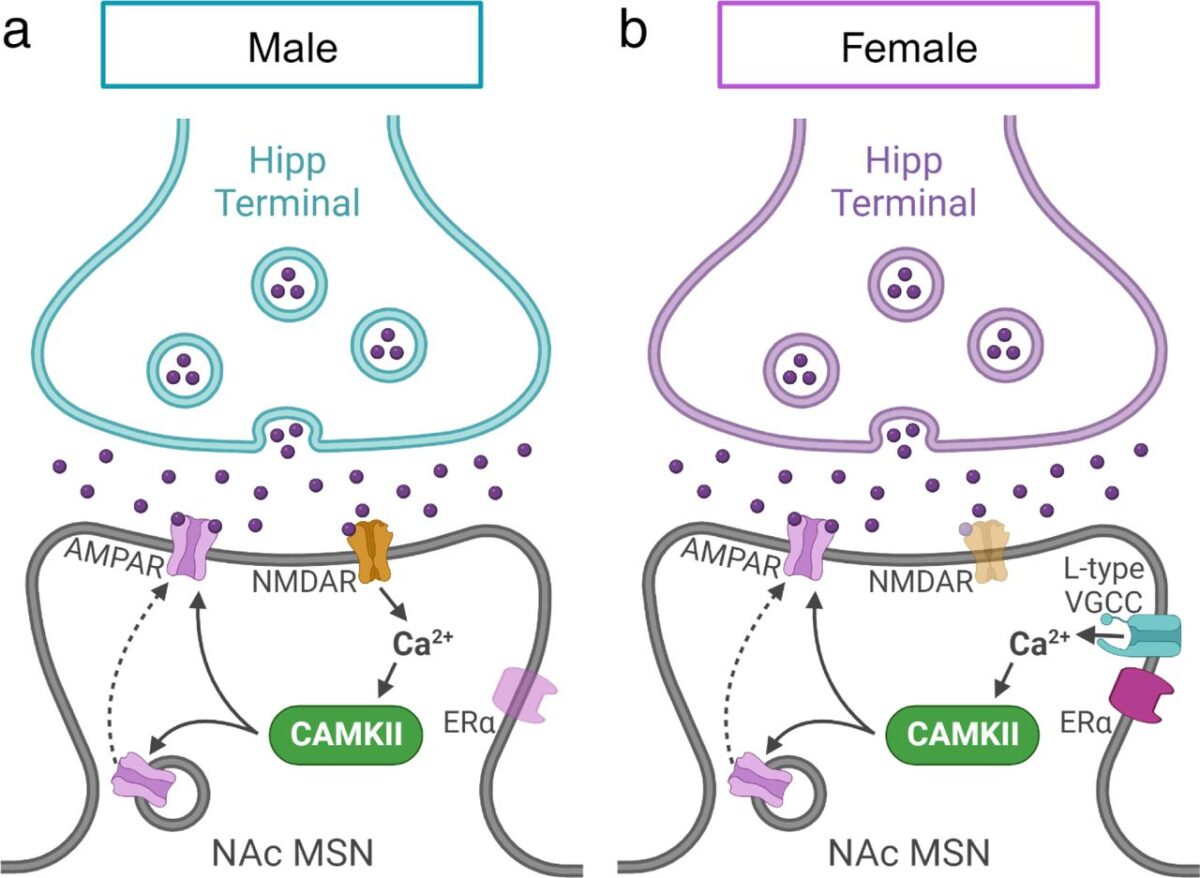A new study in the Journal of Neuroscience has discovered underlying sex differences in the molecular pathways that drive reward-related behaviors. In particular, the study found differences and similarities in the ways males and females strengthened connections between two brain regions—the hippocampus and the nucleus accumbens—involved in reward signaling.

Males and females both suffer from disorders involving these pathways, like depression and substance abuse. However, the presentation and prevalence of these conditions can differ between the sexes, and certain standard treatments are more effective on average in males or females. The new paper’s findings encourage further research to determine if the molecular differences the authors discovered may underpin differences in disease progression or medication response, which could eventually lead to more effective treatments for mental health disorders.
Although this is changing, historically, much more research has been done on male subjects (both in humans and animal models), so “we just don’t know a lot about female brains and differences between male and female brains,” says Tara LeGates, assistant professor of biological sciences and senior author on the new paper. She’s seen an increase in the number of research groups considering sex differences, and is hopeful that their work will continue to produce actionable results that lead to improved outcomes for patients.
LeGates’ previous work used optogenetics, which allows researchers to selectively stimulate particular neurons with light, to demonstrate that strengthening connections between two brain regions—the hippocampus and nucleus accumbens—is rewarding for mice. The hippocampus is best known for its roles in memory and learning, as well as emotional responses. The nucleus accumbens is a “key reward center that integrates information from different brain regions to drive goal-oriented behavior,” LeGates explains.
The hippocampus-nucleus accumbens pathway also exists in humans, and is involved in reward processes in the same way as in mice, LeGates notes, making this research highly translatable to human studies.
Surprising sex differences
The researchers used electrophysiology, which involves observing how living cells respond to stimulation of other brain regions under a microscope, to reach their conclusions about how males and females strengthen connections between the hippocampus and nucleus accumbens.
LeGates and lead author Ashley Copenhaver, a Ph.D. candidate in LeGates’ research group, found that mice of both sexes relied on activation of a particular kinase protein, CAMKII, to facilitate reward-related behavior. Neither sex required dopamine activation, which was surprising, because dopamine is commonly involved in reward-related signaling.
The neurotransmitter receptor NMDA is also commonly involved in reward pathways and strengthening connections between brain regions. The researchers found that male mice were using NMDA receptors to strengthen connections between the hippocampus and nucleus accumbens, but females were not. Instead, the females used a different channel for calcium ions and an estrogen receptor.
“We were really surprised to find this sex difference,” Copenhaver says. Because the NMDA receptor pathway is so commonly assumed to be at play, “It was just really fascinating to see, not only are males and females using different mechanisms, but one is using this NMDA receptor-dependent mechanism, whereas females are not,” Copenhaver says. “They’re using this other, non-canonical pathway—these alternative calcium ion channels. We weren’t expecting that at all.”

Revealing these differences and similarities is an important step toward making a real difference in medical care for patients.
“If you want to understand susceptibility and develop better treatments, you have to understand the mechanisms at these synapses,” LeGates says. “You have to understand what’s happening, and you have to understand it in each of the sexes.”
New approaches for better results
Legislation required human studies to include males and females in the early 1990s, but not until 2015 did the National Institutes of Health set policy that animal studies—which are frequently used to justify further human research—must also include both sexes. As a result, there are still many open questions about how male and female physiology differs, and many opportunities to make contributions with significant biomedical impact.
LeGates became more interested in studying sex differences in brain function during her postdoctoral fellowship at the University of Maryland School of Medicine. “I think that one of the problems with trying to do sex difference research is that you’re trying to use things that have been optimized to work in male animals,” LeGates says, “and then when it doesn’t play out in females, it’s just like, ‘Oh, it’s unreliable.’ But what if it’s that the tests were optimized in males, and that’s why they don’t work in females?”
“I wanted to pursue that and appreciate the male and female differences and not try to force them into the same exact paradigms,” she adds. “Maybe we need to come up with new paradigms and a new way to approach how we study them.”
Tags: Biology, CNMS, GradResearch, Research

